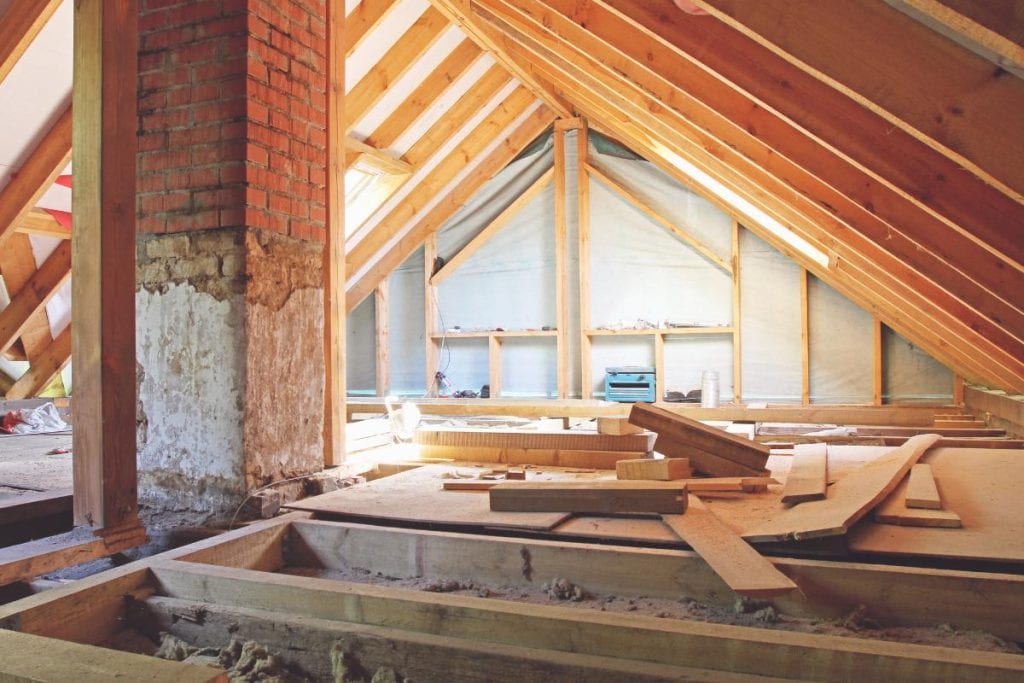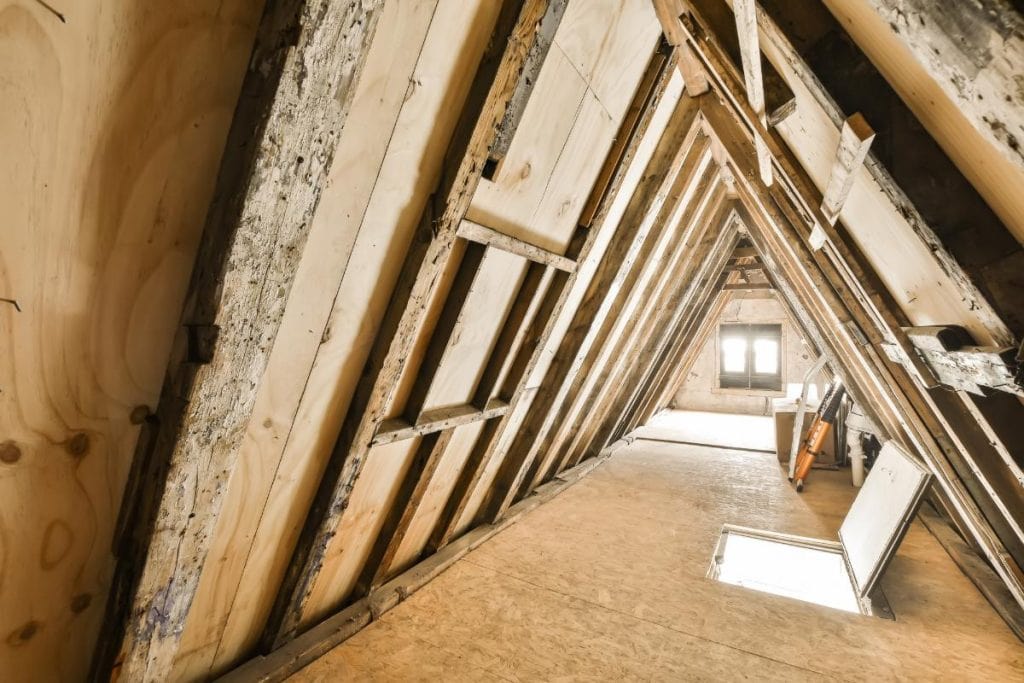Improving your home’s energy efficiency helps you save money on utility bills and create a more comfortable living environment while reducing your carbon footprint. One of the most effective places to start is your attic. Often overlooked, the attic plays an important role in regulating your home’s temperature and energy usage.
By making a few strategic upgrades, you can really boost your home’s overall efficiency. To help, we’ll explore five key attic improvements that can help you achieve a more energy-efficient home.

1. Improve Insulation
Proper insulation is a key player when it comes to an energy-efficient attic. Without adequate insulation, your home loses heat in the winter and gains unwanted heat in the summer, forcing your HVAC system to work harder and driving up energy costs.
Benefits of Proper Insulation
Good insulation acts as a barrier that slows down the transfer of heat between your attic and the rest of your home. This means your heating and cooling systems can maintain a consistent indoor temperature more easily, leading to lower energy consumption and increased comfort.
Types of Insulation
There are several types of insulation to consider:
- Fiberglass: Available in batts or loose-fill, it’s one of the most common and cost-effective options.
- Cellulose: Made from recycled paper products, it’s treated for fire resistance and works well in attics.
- Spray Foam: Provides excellent coverage and air sealing but can be more expensive.
How to Determine If You Need an Upgrade
Signs that your attic insulation may need an upgrade include uneven temperatures throughout your home, high energy bills, and drafts. You can also check the thickness of your current insulation. If it’s below the recommended level for your region, it’s time for an upgrade.
2. Seal Air Leaks
Even the best insulation can’t perform effectively if your attic has air leaks. These gaps and cracks can let in cold air during winter and hot air during summer, undermining your efforts to maintain a comfortable indoor temperature and driving up energy costs.
Identifying Common Sources of Air Leaks
Air leaks are often found around:
- Attic access doors: These can be a significant source of air leakage if not properly sealed.
- Recessed lighting: Gaps around recessed light fixtures can allow air to escape.
- Plumbing and electrical penetrations: Holes for pipes and wires are common culprits.
How to Seal Air Leaks
Sealing air leaks involves using materials like caulk, weatherstripping, and expanding foam to close gaps and cracks:
- Caulk: Best for sealing small gaps and cracks around windows, doors, and other stationary components.
- Weatherstripping: Ideal for sealing movable components, such as doors and windows.
- Expanding Foam: Great for filling larger gaps around plumbing, electrical penetrations, and attic hatches.
Impact on Energy Efficiency
Sealing air leaks can markedly reduce the amount of energy needed to heat and cool your home. This will lower your electric bill and reduce the strain on your HVAC system, extending its lifespan and enhancing your home’s overall comfort.
3. Install Attic Ventilation
Proper attic ventilation helps maintain a balanced temperature and prevents moisture buildup, which can lead to mold and structural damage. Effective ventilation helps expel hot air in the summer and prevent ice dams in the winter, making your home more energy-efficient year-round.
Importance of Attic Ventilation
Without adequate ventilation, your attic can trap heat and moisture, causing your HVAC system to work harder to maintain a comfortable indoor temperature. This increases energy consumption and raises the risk of damage to your home’s structure and insulation.
Types of Attic Ventilation
Several ventilation options can enhance your attic’s airflow:
- Ridge Vents: Installed along the peak of your roof, they allow hot air to escape from the attic.
- Soffit Vents: Placed under the eaves, they let cool air enter the attic, promoting circulation.
- Gable Vents: Located on the gable ends of the attic, these vents facilitate cross ventilation.
Choosing the Right Ventilation System
When adding a ventilation fan to an attic, consider factors such as your attic’s size, roof design, and local climate. Consulting with a professional can help you choose the most effective solution for your home.

4. Upgrade to Energy-Efficient Lighting
Attic lighting might not be the first thing that comes to mind when thinking about energy efficiency, but upgrading to energy-efficient lighting can make a noticeable difference. Traditional incandescent bulbs consume a lot of energy and generate unnecessary heat, which can impact your attic’s temperature regulation.
Benefits of Energy-Efficient Lighting
Switching to energy-efficient lighting, such as LED bulbs, offers several advantages:
- Lower Energy Consumption: LEDs use significantly less energy than incandescent bulbs.
- Longer Lifespan: LED bulbs last much longer, reducing the frequency of replacements.
- Reduced Heat Output: LEDs emit very little heat, which helps maintain a stable attic temperature.
Best Practices for Attic Lighting
- Placement: Ensure lights are strategically placed to provide adequate illumination without overlighting the space.
- Motion Sensors: Consider installing motion sensor lights to ensure they are only on when needed.
- Task Lighting: Use task lighting for specific areas where you need focused light, such as workspaces or storage areas.
Upgrading to energy-efficient lighting in your attic is a simple yet effective way to enhance your home’s overall energy efficiency, reduce energy costs, and create a safer, more functional space.
5. Add Reflective Barriers
Reflective barriers, also known as radiant barriers, can reduce heat gain in your attic. These barriers reflect radiant heat away from your home, keeping your attic cooler and reducing the load on your cooling system.
How Reflective Barriers Work
Reflective barriers are typically made from a reflective material, like aluminum foil, which is installed on the attic floor or roof. They work by reflecting radiant heat away from your attic, preventing it from entering your home and raising indoor temperatures.
Benefits of Reflective Barriers
- Reduced Cooling Costs: By keeping your attic cooler, reflective barriers reduce the need for air conditioning, leading to lower energy bills.
- Enhanced Comfort: A cooler attic translates to a more comfortable home, especially during the hot summer months.
- Extended Roof Life: Reducing heat in the attic can prevent premature aging of roofing materials, extending the lifespan of your roof.
Installation Tips
- Location: Reflective barriers can be installed on the attic floor, roof rafters, or walls, depending on your specific needs and attic design.
- Professional Installation: While DIY installation is possible, hiring a professional ensures optimal placement and maximum effectiveness.
- Compatibility: Make sure the reflective barrier is compatible with your existing insulation and ventilation systems.
Adding reflective barriers to your attic is a cost-effective way to enhance your home’s energy efficiency. This simple upgrade can lead to significant energy savings, improved comfort, and a longer-lasting roof.
Upgrading your attic is a smart investment that can boost your home’s energy efficiency. By improving insulation, sealing air leaks, installing proper ventilation, upgrading to energy-efficient lighting, and adding reflective barriers, you can create a more comfortable and sustainable living environment. These changes not only lower your energy bills but also contribute to the longevity and health of your home.
